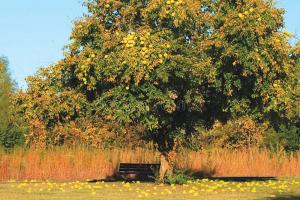Osage Orange Trees Can Be Useful
 ✖  |
Though they really don’t repel spiders, the Osage orange tree’s odd-looking fruits are intriguing, and the tree itself has played a part in the agriculture and hunting history of the U.S. Native to the south-central U.S., the trees are found over much of the U.S. and in parts of Canada.
Mature trees grow 35 to 50 ft. tall with trunks up to 2 ft. in diameter, with the branches naturally growing into a round shape. Though the trunks are generally too crooked and knotty to harvest for lumber, and thorns make Osage orange trees difficult to maintain, the wood has impressive qualities.
The Osage Indian Nation Tribe likely inspired the name for the tree in the 16th century because they used its wood to make good bows, and it’s still used in bows made today. The wood’s flexibility was used by French settlers to create wagon wheels that absorbed shock and held up to moisture and mud.
Many trees were cut for firewood. When seasoned properly, Osage orange produces more Btu than any other hardwood, according to FirewoodResource.com. The decay-resistant wood was also used for railroad ties, and it makes long-lasting fence posts.
But one of the most creative uses for the trees was during the mid-1930’s when the WPA (Works Progress Administration) included Osage orange trees in the 200 million trees planted in windbreaks over 18,000 miles to prevent soil erosion in the Great Plains.
Homesteaders planted the trees close together to create a thorny hedge and natural cattle fencing. That use gave the fruit its hedge apple nickname.
The bitter grapefruit-sized fruit is inedible to humans, and squirrels are the only animals to find it palatable. Somehow it gained a reputation for repelling spiders, which has never been scientifically proven. However, when sliced open, the milky sap inside deterred some insects, according to a study from Iowa State University Extension and Outreach.
According to Pennsylvania State Extension, the tree and its fruit have their uses. The fruit can be part of autumn decorations and look like “brains” for Halloween displays. The wood makes great fence posts and is used to make bows, boats, woodwind instruments, waterfowl game calls, and specialty wood items.
Osage orange is related to fig and mulberry trees and can be grown in Zones 4-9 in most soils. Trees can be started directly from seed.
The trees require maintenance and should not be allowed to become invasive. Thorns make them challenging to cut and control, and the fallen fruit should be picked up and removed.
Just don’t plan on using the fruit to repel spiders.

Click here to download page story appeared in.
Click here to read entire issue
Osage Orange Trees Can Be Useful CROPS Miscellaneous Though they really don’t repel spiders the Osage orange tree’s odd-looking fruits are intriguing and the tree itself has played a part in the agriculture and hunting history of the U S Native to the south-central U S the trees are found over much of the U S and in parts of Canada Mature trees grow 35 to 50 ft tall with trunks up to 2 ft in diameter with the branches naturally growing into a round shape Though the trunks are generally too crooked and knotty to harvest for lumber and thorns make Osage orange trees difficult to maintain the wood has impressive qualities The Osage Indian Nation Tribe likely inspired the name for the tree in the 16th century because they used its wood to make good bows and it’s still used in bows made today The wood’s flexibility was used by French settlers to create wagon wheels that absorbed shock and held up to moisture and mud Many trees were cut for firewood When seasoned properly Osage orange produces more Btu than any other hardwood according to FirewoodResource com The decay-resistant wood was also used for railroad ties and it makes long-lasting fence posts But one of the most creative uses for the trees was during the mid-1930’s when the WPA Works Progress Administration included Osage orange trees in the 200 million trees planted in windbreaks over 18 000 miles to prevent soil erosion in the Great Plains Homesteaders planted the trees close together to create a thorny hedge and natural cattle fencing That use gave the fruit its hedge apple nickname The bitter grapefruit-sized fruit is inedible to humans and squirrels are the only animals to find it palatable Somehow it gained a reputation for repelling spiders which has never been scientifically proven However when sliced open the milky sap inside deterred some insects according to a study from Iowa State University Extension and Outreach According to Pennsylvania State Extension the tree and its fruit have their uses The fruit can be part of autumn decorations and look like “brains” for Halloween displays The wood makes great fence posts and is used to make bows boats woodwind instruments waterfowl game calls and specialty wood items Osage orange is related to fig and mulberry trees and can be grown in Zones 4-9 in most soils Trees can be started directly from seed The trees require maintenance and should not be allowed to become invasive Thorns make them challenging to cut and control and the fallen fruit should be picked up and removed Just don’t plan on using the fruit to repel spiders
To read the rest of this story, download this issue below or click
here to register with your account number.







